 it
it  en
en
Archive 2017
Interesting case of a take-off clearance cancellation by the TWR operator that had observed an animal on the runway (January 7).
This is interesting because not every country attributes this responsibility to the controller, with the related obvious obligation to look out in order to identify the presence (also) of wildlife. Actually the Indian ATM manual states: ““In the event the aerodrome controller observes ... any obstruction .... such as animals or flock of birds…”
The word "observes"does not appear in the ATM manuals of other countries, nor even in the ICAO DOC 4444, which uses instead the more ambiguous term "becomes aware". India's regulation thus appears to be a commendable exercise of clarity for safety.
- 15 December 2017 – Toronto
Air Canada ERJ 190, during the take off a Snowy owl (Bubo scandiacus) struck the nose gear causing damage to theleft side landing gear aft door that did not allow to retract the gear; the crew declared emergency and landed back; - 6 January – Nantes
Travel Service Poland/Smartwings B737, during the initial climb flew through a flock of birds; the right engine ingested a number of birds prompting the crew to land back about 10 minutes after departure; a post flight inspection revealed 3 fan blades of the right engine were damaged;
https://www.ouest-france.fr/pays-de-la-loire/nantes-44000/nantes-un-boeing-737-percute-des-oiseaux-au-decollage-et-fait-demi-tour-5488693 - 7 January – Udaipur (India)
Jet Airways B737, rejected take off following the cancellation of their takeoff clearance by the TWR because a Jackal (Canisaurusindicus)had been spotted on the runway;
(Indian Jackal; Photo taken from Wikipedia)
- 17 January - Salt Lake City (UT)
Alaska Airlines B737, suffered a bird strike during the take-off run; the crew decided to continue the flight to destination (Seattle); the aircraft sustained unknown damage due to the bird strike and was grounded for maintenance; - 17 January – Nampula (Mozambico)
LAM LinhasAereas de Mocambique B737, rejected take off at high speed further a bird ingestion into the left engine - 19 January – Guwahati (India)
Air India A321, during the approach a bird struck the airframe probably causing a hole; the aircraft has been grounded for controls;
https://www.ndtv.com/india-news/air-india-flight-with-160-aboard-suffers-bird-hit-while-landing-in-guwahati-1802449 - 23 January – Algiers
Air Algerie A330, during the initial climb suffered a bird impact that caused abnormal indication from an engine; immediate return;
http://www.lexpressiondz.com/actualite/284672-un-avion-d-air-algerie-percute-des-oiseaux.html - 23 January – Edimburgh
Stobart Air ATR72, a bird strike after take off prompted the crew to land back; minor damage;
https://stv.tv/news/east-central/1406830-edinburgh-bound-flight-turns-back-after-hitting-bird - 24 January – Amsterdam
LATAM B777,was on final approach when a flock of birds flew into the way of the aircraft, one bird impacted the underside of the fuselage, another bird was ingested by the left hand engine;
http://www.youtube.com/watch?v=GigjNyv3OJ8 - 25 January – Lisbon
TAP A319, in the initial climb a bird impacted the windscreen while reduced power on the right engine was reported; immediate return about 15 minutes after departure; flight cancelled; - 29 January – Zagreb
Croatia Airlines A319, during the climb suffered a bird strike and returned for landing back about 40’ after departure; radome damaged; - 30 January – Islamabad
Airblue A321, after take-off ingested a bird into one of its engines; the crew continued the climb but then decided to return due to some abnormal engine indications about 35 minutes after departure; - 4 February – Sacramento (CA)
Southwest B737, during the initial climb a bird impacted the aircraft prompting the crew to land back 10’ later; minor damage;
http://sacramento.cbslocal.com/2018/02/04/bird-strike-causes-emergency-landing-at-sacramento-international-airport - 7 February – Ahmedabad
GoAir A320, during the initial climb a bird impacted the aircraft prompting the crew to land back 11’ later;
https://www.latestly.com/india/information/goair-720-ahmedabad-delhi-flight-suffers-bird-hit-today-flight-cancelled-all-passengers-safe-22090.html - 8 February – Johannesburg
Comair B737, during the initial climb suffered a strike with a medium sized bird, probably a Grey Hooded Gull (Chroicocephaluscirrocephalus); immediate return 20’ later;
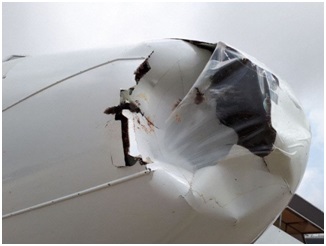
(The nose of the aircraft; photo taken from Avherald.com)
- 10 February – Portland (OR)
United A319, bird strike during the approach; - 16 February – between Dakar (Senegal) and Banjul (Gambia)
Brussels Airlines A330, after landing in Banjul a post flight inspection revealed the aircraft had received a bird strike during the flight and was unable to continue schedule; the flight was postponed by 49 hours and operated by another aircraft; - 18 February – Bhubaneswar (India)
Indigo A320, at take-off hit an owl and made a precautionary landing; no damage reported;
http://odishatv.in/odisha/body-slider/bhubaneswar-new-delhi-indigo-flight-makes-emergency-landing-after-bird-strike-277286 - 20 February – Zurich
Swiss Global Airlines Bombardier CS300, during the initial climb the crew reported they had hit a large bird during the departure roll, but they wanted to continue for now; later suspecting some engine damage landed back about 30 minutes after departure; flight cancelled; - 22 February – Nagpur (India)
Air India A320, during the final approach a bird impacted the right hand wing causing damage to the right hand flaps; the aircraft was unable to continue its schedule; - 22 February – Kish (Iran)
Kish Air Fokker 100, a bird strike at take-off is believed to have caused a later windshield crack and a diversion to the closest airport; - 23 February - Tuxtla Gutierrez (Messico)
Interjet A320, during the initial climb a bird struck the left engine prompting the crew to land back; - 27 February – Siargao (Philippines)
Skyjet Airlines Bae146, after landing suffered a runway excursion; the aircraft stopped in the grass, just past the runway end; the cause of the incident is said to be a bird strike; dead birds were reportedly found on the runway;
https://news.mb.com.ph/2018/02/27/jet-overshoots-runway-in-siargao-all-passengers-safe
https://aviation-safety.net/wikibase/wiki.php?id=206822 - 28 February – Izmir
Turkish Airlines B737, bird strike during the initial climb and crew decision to land back; flight cancelled; - 3 March – Nashville (TN)
Republic Airlines ERJ170, after take-off the crew reported they had a potential bird strike and requested a runway inspection while climbing out; despite the runway inspection had found debris, the crew decided to continue the flight to destination where damage was found caused by the bird strike; - 5 March – Tehran
Lufthansa B747, on final approach the inboard left hand engine ingested a bird; the aircraft was unable to depart for the return flight; - 10 March – Albuquerque (NM)
Delta B757, during the initial climb an engine ingested a bird and landed back; - 11 March – Atlanta (GA)
Delta MD90, during the initial climb the crew declared emergency further to a bird ingestion into the left engine that caused its failure; immediate return 30’ after departure; - 11 Marzo – Kumasi (Ghana)
- Africa World Airlines ERJ 145, on landing hit a bird; no damage reported;
http://citifmonline.com/2018/03/12/awa-renews-commitment-safe-flights-kumasi-incident - 15 March – Tampa (FL)
United A320, in the initial climb the crew reported they had taken a number of bird strikes during the take-off roll but wanted to continue their departure. About a minute later the crew reported they had a problem with the pitot #2 and wanted to return then decided to burn off fuel for about 3 hours and landed back. A runway inspection found and recovered multiple birds on the runway. - 15 March – Joao Pessoa (Brazil)
GOL B737, during the initial climb struck a bird and returned for landing; - 17 March – Baltimore (MD)
Southwest B737, on final at about 7 NM from the runway flew through a flock of birds receiving damage; - 22 March – Hong Kong
Air China B737, after landing the ground staff noticed the radome had received a hole of about 1 meter in diameter;blood stains suggested the aircraft may have suffered a bird strike. The crew had not reported any anomaly;
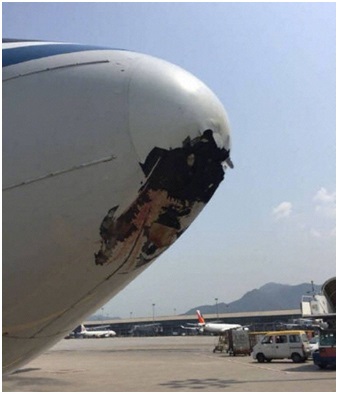
(The damaged radome; photo taken from Avherald.com)
- 25 March – Lahore
Serene Air B737, bird strike on final; the aircraft was unable to depart for the return flight; - 25 March – Los Angeles (CA)
Air China B777, suffered minor damage on landing due to a bird strike; the aircraft was unable to fly its next leg; - 27 March – Murcia
Easyjet A319, was lining up the runway for departure when the right engine ingested a number of birds resulting in an engine fire indication; the crew shut the engine down and discharged a fire bottle; - 29 March – Riberalta (Bolivia)
Amaszonas Linea Aerea SA227 Metro, during the takeoff roll a flock of birds impacted the right engine causing the crew to reject takeoff; the aircraft veered off the runway and came to a stop down a slope; no injuries are being reported;
https://www.eldeber.com.bo/bolivia/Avion-de-Amaszonas-se-accidenta-en-Riberalta-20180329-8268.html
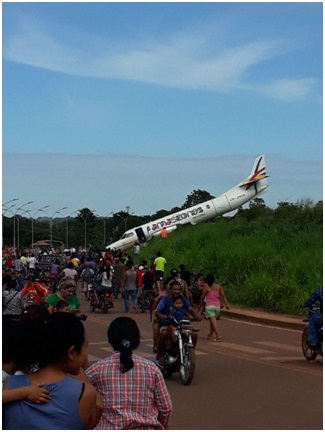
(The aircraft down the slope. Photo Fernando Galvan taken from eldeber.bo)
- 29 March – East Midlands
Ryanair B737, during the initial climb a bird impacted the aircraft causing damage to the windshield; the crew decided to land back about 10 minutes after departure; - 31 March – New York (JFK)
Delta A319, during the initial climb the left engine ingested a bird and began to vibrate; the crew shut the engine down and landed back 13’ after take-off;
http://abc7ny.com/delta-flight-lands-safely-at-jfk-airport-after-bird-strike/3286826

(The left engine after landing; photo Port Authority Police taken from Avherald.com)
The American NTSB released the factual report regarding the accident suffered by a Southwest B737 on 23.12.2013. The right engine ingested a number of Mallard Ducks (Anas platyrhynchos) and suffered an uncontained engine failure; there was evidence that a piece of high-speed debris had exited the engine through the outboard fan cowl near the fan plane.
Despite the closure of the Scarpino landfill, the problem of gulls at Genoa airport seems to persist. The November 5 event is similar to others of the past: a flock of gulls settled on the runway suddenly flew up in front of the taking-off aircraft. The most impressive precedent dates back to June 7, 1989, and gave rise to a long sequel of civil proceedings for compensation of the damage suffered by a TNT Bae 146.
In similar circumstances, it was less fortunate and suffered multiple impacts that led to the loss of an engine and the shutdown of two others immediately after the emergency landing. In 1997, however, it was the turn of an Antonov 124 to suffer the same fate but in the trial that followed the defendants managed to prove that the flock of seagulls were not settling on the runway but crossed it at low altitude in an unforeseen and unpredictable way. Despite these two famous court cases, once again we read about flocks of gulls settling on the ground near the runway without anyone, not the bird control, nor the Tower, nor anybody else, seeing and dispersing them.
- 27 September – Toronto
Air Canada ERJ190, during the initial climb through 1000 feet a bird impacted the right hand engine and causing minor damage; the crew landed back about 25’ later; - 1 October – Istanbul
THY A321, during the initial climb flew through a flock of birds and received a number of bird strikes prompting the crew to land back about 17’later; an engine inspection revealed damage;
- 1 October – Chandigarh (India)
Jet Airways B737, at the departure received a bird strike into one of the engines prompting the crew to continue the flight but diverting to Delhi, where the aircraft landed safely about 110’ later; reportedly a number of fan blades were found damaged; - 3 October – Sacramento (CA)
Southwest B737, on final approach a bird impacted the aircraft and caused minor damage; the aircraft was unable to continue its schedule however; - 3 October – Conklin (Christina Lake Airstrip, AB Canada)
Sunwest Dash 8, on landing collided with two deer that suddenly crossed the runway; the aircraft received minor damage to the radome, nose landing gear doors and left propeller;
https://globalnews.ca/news/3784390/northern-alberta-airport-shut-down-after-plane-hits-2-deer-on-runway/ - 9 October – Wilmington (NC)
PSA Airlines CRJ900, during the take-off run hit a coyote that caused damage to the nose gear; the aircraft landed back 30’ later and the flight was cancelled; - 9 October – Rockford (IL)
UPS B757, bird strike during the approach; minor damage to a landing light; - 11 October – Managua
American Airlines B737, during the take-off run a vulture impacted an engine causing its failure; immediate return 10’ later; the engine was severely damaged; - 12 October – Orlando (FL)
American Airlines A321, bird strike during the approach; minor damage; - 13 October – Mombasa (Kenya)
THY B737, during the initial climb an engine ingested a bird; the crew entered a hold to burn off fuel for about 2.5 hours and landed back about 2:50 hours after departure; - 14 October – Salt Lake City (UT)
Delta B737, was climbing through 6000 ft. when a bird impacted the nose of the aircraft; in the absence of any abnormal indications the crew continued the flight to destination (65’); damage to the radome; - 17 October – Leipzig
Eurowings A320, during the take-off run the crew rejected take-off at high speed; the aircraft was subsequently towed to the apron with the fire engines in trail but was able to depart about 2 hours later. According to some sources the take-off was rejected due to a bird strike; according to some eye witnesses the aircraft did not hit any birds instead, the TWR instructed the crew to abort the take-off, as a follow-me-driver observed a large flock of birds along the runway; - 19 October – Sao Paulo
LATAM Brazil B777, during the initial climb a bird impacted the right engine; the crew continued the climb up to the cruise flight level but then decided to return to Sao Paulo due to the bird strike, about 3 hours after departure;

(The right engine seen after the landing; photo taken from Avherald.com) - 20 October – Melbourne
Virgin Australia B737, during the climb the crew reported excessive left hand engine vibrations and decided to return to Melbourne advising that an eagle carrying a rabbit had just impacted their #1 engine; the aircraft landed back about 17 minutes after take-off; - 20 October – McAllen (TX)
Mesa Airlines CRJ900, on final approach a bird impacted the nose of the aircraft; the return flight was cancelled; minor damage to the nose cone; - 21 October – Fort Lauderdale (FL)
Southwest B737, after take-off the aircraft sustained a bird strike to the nose gear; in the absence of abnormal indications, the crew continued the flight until they decided to divert to Baltimore due to a hydraulic leak further to the bird strike onto the nose wheel hydraulic line;
- 23 October – Boston
JetBlue A320, after take-off the crew reported they had a bird strike at the left side that may have impacted the engine, it was probably a flock of sea gulls; during the procedures for completing the checklist and burning off fuel, the weather rapidly deteriorated in Boston and therefore the crew decided to divert to New York JFK. They advised everything appeared to be functioning normally, but maintained the emergency status and wanted emergency services follow them to the gate at JFK where they landed safely about 3:10 hours after departure; - 23 October – Goa (India)
Indigo A320, was accelerating for takeoff when a stray dog entered the runway prompting the crew to rejected takeoff at high speed (about 150 kts); the aircraft slowed safely but became disabled with a number of main tyres deflating due to brakes overheating; it was able to depart about 2:50 hours later; - 25 October – Seoul (Gimpo)
Asiana Airlines A321, in the initial climb the right engine ingested a bird prompting the crew to stop the climb and land back about 25 minutes after departure; several fan blades were damaged; - 26 October – Vienna
Austrian B767, during the initial climb the right engine ingested several birds; the crew initially continued to climb but later landed back after one hour; the flight was cancelled and the passengers were rebooked onto other flights; - 26 October – between Charlotte (NC) and Orlando (FL)
American Airlines A321,after an uneventful flight an inspection revealed that the aircraft sustained damage to the nose cone as result of a bird strike; - 26 October – Salt Lake City
Delta B757, during the approach an engine ingested a bird, briefly stalled and recovered; other aircraft reported seeing a flock of birds around 500 feet AGL; - 29 October – Minneapolis
Republic Airlines ERJ175, bird strike on final approach; the aircraft sustained minor damage to a windscreen wiper;
http://www.thehindu.com/news/national/tamil-nadu/peacock-hits-air-arabia-flight-while-landing-in-coimbatore-airport/article19944019.ece - 29 October – Coimbatore (India)
Air Arabia A320, during the approach a bird, reportedly a peacock, impacted the aircraft and penetrated the left wing root fairing; the aircraft was unable to depart for the return flight and remained on the ground for about 17 hours; - 31 October – Salt Lake City
Jetblue A320, in the initial climb the crew reported they had received a bird hit; after a first decision to continue the flight they landed back about 40’ later; reported damage to engines and leading edge of wings; - 2 November – Fukuoka
JAL B737, during the initial climb at 6000 feet suffered a bird ingestion into the left engine and landed back about 50 minutes after departure;
https://headlines.yahoo.co.jp/hl?a=20171102-00000060-jij-soci - 3 November – Wellington
Air New Zealand A320, rejected takeoff at high speed (about 100 knots) due a bird strike affecting an engine; the aircraft was able to depart about one hour after the rejected takeoff; - 4 November – Saint Louis (MO)
Southwest B737, on final a bird impacted an engine cowling causing minor damage; - 5 November – Des Moines (MI)
Endeavor Air CRJ900 on finalapproach the aircraft received a number of bird strikes and sustained substantial damage; - 5 November – Washington (DC)
Southwest B737, on approach received multiple bird strikes that caused damage to the radome and the wings; - 5 November, Rhodes
Ryanair B737, during the acceleration for takeoffthe crew observed a pack of dogs straying onto the runway but was unable to prevent the aircraft hitting one of them; the crew continued takeoff but landed back about 13 minutes after departure; since a control revealed no damage, the aircraft was released back to service; - 5 November – Genoa
Volotea B717, was accelerating for takeoff when a flock of sea gulls flew up from the runway; one of the birds impacted the right hand windshield prompting the crew to successfully reject takeoff at high speed (about 125 knots over ground); - 7 November – Salt Lake City (UT)
Jetblue A320, on final approach about 5nm before touchdown a bird impacted the right hand wing causing minor damage; - 11 November – Rio Branco (Brazil)
LATAM A321, during the initial climb a bird hit the aircraft; immediate return 22’ after take off; - 12 November - Vishakhapatnam (India)
Indigo A320, during the acceleration for takeoff, the crew observed a wild boar on the runway; being unable to deviate around the boar, the crew decided to rotate the aircraft early but to return to the airport to have the aircraft checked for any possible damage. Given the need to burn fuel, the aircraft landed back after one hour in flight; no damage reported further to the inspection; - 14 November – Alghero
Ryanair B737, during the approach an engine ingested a gull; next flight left with a 6,5 hour delay; http://notizie.alguer.it/n?id=128301 - 14 November – Miami (FL)
American Airlines A319, on approach a goose struck the aircraft and remained embedded in the radome; the aircraft remained on the ground for about 11 hours;

(The goose hanging off the radome – Photo by Planespottermania Taken from Avherald.com) - 15 November – Tampa (FL)
Southwest B737, bird strike at take-off; in the absence of any abnormal indications the crew continued the flight to destination about 2:20 hours later; on arrival an inspection revealed that the aircraft sustained damage to the horizontal stabilizer which made it unable to continue its schedule; - 15 November- Chennai (India)
an aircraft bound to Ahmedabad, type and airline unkown, suffered a bird strike at 5,500 ft. and was forced to land back; - 16 November – Chennai (India)
Indigo A320, at take off a bird struck the aircraft near the left hand engine prompting the crew to land back about 15’ minutes after departure;damage to a landing light and the leading edge of the wing; - 17 November – Philadelphia (PA)
American Airlines A321, during the initial climb the climb a bird impacted the aircraft; the crew burned off fuel and returned to the departure airport about 2:11 hours after departure; damage to fuselage and flap track; - 18 November - Kathmandu
Nepal Airlines A320, during the approach an eagle impacted the nose of the aircraft, momentarily blended with the nose section causing a large dent and dropped off;
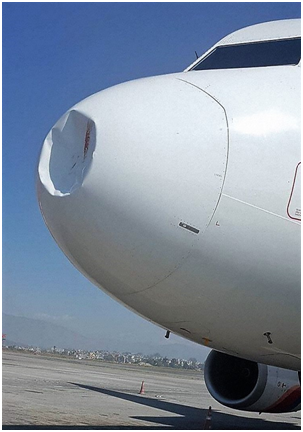
(L’A320 dopo l’atterraggio; foto di SusheelBhattarai tratta da Avherald.com) - 18 November - Delhi (India)
GoAir A320, during the initial climb a bird struck the aircraft prompting the crew to land back about 20’ minutes after departure; the nose of the aircraft sustained damage; - 19 November – Johannesburg
Mango B737, during the initial climb out a bird impacted the left hand engine inlet causing a dent; the crew decided to land back that happened 25’ after departure;
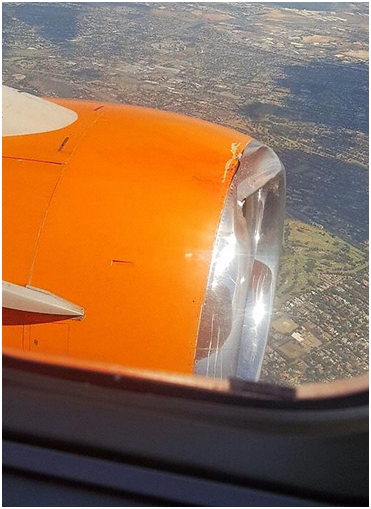
(The left engine. Photo by Sergio Davids taken from Avherald.com) - 19 November – Sacramento (CA)
Horizon Air DHC8, on approach a bird impacted the nose of the aircraft; the aircraft sustained substantial damage; - 22 November – San Francisco
United B737, was accelerating when the crew rejected takeoff at about 90 knots over ground due to a bird strike, probably with a turkey vulture; - 22 Novembre – San Francisco
Skywest ERJ175, during the initial climb an engine ingested a bird prompting the crew to land back about 10 minutes after departure; - 24 November – Coffs Harbour (Australia)
Sunstate Dash 8, on a final approach a bat impacted the aircraft; the aircraft was unable to continue its next sector; the impacted bat,belonging to the genus Pteropus,is locally known as Flying Foxand can have a wingspan up to 1,80mt. and a weigh up to 1,60 kg. - 29 November – Saint Petersburg
Aeroflot B737, on approach a bird impacted the radome and remained embedded; return flight cancelled; - 29 November – Sacramento (CA)
Southwest B737, during the initial climb suffered a bird strike at the right hand side; the right hand engine rolled back a little bit and the crew decided to land back 8’ after take off; - 1 December – Amsterdam
Transavia B737, bird strike on landing that does not allow the aircraft to fly the next leg; - 3 December – Torreon (Mexico)
VivaAerobus A320, during the approach flew through a flock of birds and suffered several impacts on the right engine; the aircraft however departed for the next scheduled flight and continued to operate on schedule throughout the rest of the day as well as the following day. Later on the Authority confirmed the right engine sustained unknown damage; the occurrence was rated a serious incident. - 4 December – Sacramento (CA)
Delta A320, during the initial climb at about 1000 ft. flew through a flock of birds and suffered several impacts; the crew decided to land back immediately declaring emergency.An inspection revealed evidence of ingestion in both engines and damage to the left wing slats and the radome; bird strikesigns were visible on both engines, the windshield, both wings, and the nose; bird carcasses of 11 Snow Geese (Ansercaerulescens) and 1 Ross’ Goose (Anserrossii)involved in the strike have been found later; - 6 December – Enschede (Olanda)
KLM, B747, at least three roe deer crossed the active runway immediately after theaircraft landing;
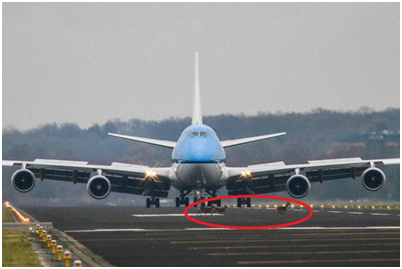
(The roe deer crossing the runway. Photo by SjoerdDrost taken from Avherald.com) - 9 December – Spokane (WA)
United B737, during the approach flew through a flock of birds and suffered multiple impacts; damage to the wings and the tail; - 10 December – Oakland (CA)
Fedex B767, bird strike during the approach; unknown damage; - 17 December – Istanbul (Ataturk)
THY A321, during the initial climb was struck by a bird and landed back 17’ after departure; - 22 December – Chennai
Air Asia A320, rejected take off at low speed further to the ingestion of a bird into the left engine; a number of fan blades found damaged; - 31 December – Hamburg
British Airways A319, on final a bird struck the aircraft destroying one of the pitot tubes; return flight cancelled;
The Indian Authority AAIB released the final report (http://dgca.gov.in/accident/reports/VT-SUC.pdf) regarding the investigation on the accident occurred on 4.12.2015 to the aircraft Bombardier Q 400 at the airport of Jabalpur.
During the night landing the aircraft hit a number of wild boars that had entered in the airport and were crossing the runway. The investigation highlighted several breaches in the perimeter wall as well as poor maintenance.
The Australian Authority released the final report (http://www.atsb.gov.au/media/5773811/ao-2015-007_final.pdf ) further to the investigation regarding the event of Jan 9 2015, occurred to a SAAB 340 aircraft on Moruya airport. After the landing, a flock of “galhas” took off from the grass west of the runway and impacted the aircraft. The crew carried out a visual examination but did not identify any damage. However, after the next flight the crew observed that the tip of one of the left propeller blades had detached.
Recently, has been brought to our attention the story of a Polish passenger who complained about the delay of her flight asking for the financial compensation as provided for by the European legislation. The airline claimed that the compensation was not due because the delay was caused by a bird strike, which constitutes an "extraordinary circumstance" that exonerates it from liability, as recently established by a sentence of the European Court of Justice
However, the passenger did not believe in the official version and did not lose heart. She therefore invoked the provision of the art. 5 para. 3 of the European Regulation 261/2004 which lays down an obligation for the carrier to prove the actual occurrence of the extraordinary circumstance, a bird strike in this case. Nothing’s that simple, because it would be enough to produce a copy of the bird strike reporting form that, at least in Europe, all carriers must fill to report the event to the Authority.
But this is where the problems start because the airline objected that such information should be considered confidential, and so did the competent authorities the passenger has so far addressed. To be honest, they do not deny that eventually an answer could be given but only at the end of long drawn-out procedures and at the discretion of the authority itself that might even refuse.
A first general consideration concerns the alleged extraordinariness of these events that frankly appears incomprehensible even by looking at public statistics, including ours. Bird strikes are, on the contrary, daily events and a delay due to these is the norm. Evidently, judges do not speak the same language used in aviation. And that would not be a novelty.
A second reflection concerns the protection of the passenger’s rights: opposing to those the protection of the airline privacy is even more incomprehensible because we really do not understand what is the good to be protected. A collision with a bird is not a shame to hide, nor an issue that concerns only certain areas or airports. It is a phenomenon unfortunately widely spread and affecting everyone.
It is therefore legitimate to suspect that, under the pretext of the privacy protection, some airlines hide behind the "extraordinary circumstance" other reasons of delay, this time dependent on the airline itself, which would instead result in financial compensation. In other words, to save money on the back of passengers. And this was certainly not the will of the European legislator or, we believe, of the Court of Justice. A well-known Italian politician once said that thinking the worst of someone is a sin, but most of the time you are spot on.
It’s time to begin fixing all this.
The European Agency for the Aviation Safety (EASA) recently proposed to amend the CS-E (certification specifications for engines) to require the applicant to demonstrate the ability of a turbine engine to cope with the ingestion of a medium flocking bird into the engine core and solicited comments on this issue. Cpt. Paul Eschenfelder and Dr. Valter Battistoni (owner and manager of this website) submitted to EASA their observations.
In our view, the most relevant event of the quarter was not the loss of an aircraft with the injuring of some crew members (July 29, at Sao Tomé) due to a dual bird ingestion into both engines, but rather what took place in Stuttgart on August 13.
An Airbus A319 was accelerating for take-off when the left engine ingested a bird (probably a heron) that caused serious damage to all fan blades. Fragments of these blades accelerated forward impacting the engine inlet as well as the slats/flaps and forward fuselage. Fragments also bounced up from the runway to the right hand side and were ingested by the right hand engine resulting in fan blade damage of the right hand engine, too.
The left engine inlet received several punctures, the fan case, slats/flaps and forward fuselage several dents.
The takeoffwas interrupted at high speed after about a 2000 mt. run.
Why do we consider this event more relevant than the other, which even resulted in afinancial irreparable damage?
Firstly, because the German authorities oddly did not open an investigation, that in this case is importantnot only in order to find out the causes, but above all for the safety recommendations that could arise from it. The consideration that the damaged parts were rotable components, engines or parts of them, moreover because of a bird, probably led to a lesser attention. In case of a mechanical failure, for example, their reaction would probably have been different. Once again, it is necessary to point out that also aeronautical investigators (and regulators) need to be properly trained to understand that there is a wide scope of action in the wildlife arena.
Secondly, because it is now incontrovertible that a single bird ingestion may cause the failure of both engines at take-off (not important that it actually not happened, because as a matter of fact all the conditions were present).
Thirdly because the risk was very high. The left engine had a total power loss; it is not possible to ascertain what damage suffered the right one, but the ingestion of metallic parts leads to believe that it was serious enough to compromise the take-off and the subsequent emergency landing.
Moreover, this event will not be classified as a dual bird ingestion, as for the aviation statisticians the damage to the right engine was a consequence of the unique bird ingestion into the left. This may satisfy the statistics but not the people involved in safety, especially if the event is observed in the viewpoint of the SMS (Safety Management System).
- 30 June – Bogota
Avianca A320, on final approach a vulture penetrated the radome of the aircraft and came to rest inside the radome;

(Photo taken from Avherald.com) - 2 July – Helsinki
Finnair A319, during the initial climb received a bird strike; the crew decided to land back 35’ later; - 2 July – Belgrade (MT)
Horizon Air Dash 8, during the initial climb received a bird strike that caused damage to a pitot tube; immediate return 15’ later; - 3 July – Coolangatta (Australia)
Air Asia X A330, during the initial climb the crew reported problems to the right engine due to a suspected bird ingestion and decided to divert to Brisbane; an inspection revealed carcasses of plovers on the departure runway;
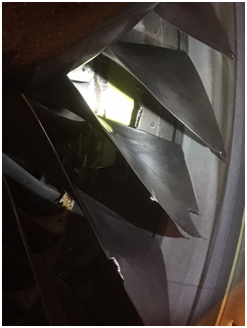
(The damaged engine; photo taken from Avherald.com) - 6 July – Klagenfurt
Germanwings A320, following a bird strike on landing the aircraft was unable to perform the next flight; - 10 July – Kayseri (Turchia)
THY B737, during the initial climb suffered a bird strike and landed back 10’ later; - 11 July – Denver (CO)
United B737, during the initial climb the right engine ingested a bird but was still running; the crew decided to land back requesting emergency services due to an overweight landing; minor damage; - 11 July – Peshawar
PIA A320, on approach a bird impacted the left hand wing root fairing causing a fairing panel above the wing to detach and depart the airframe;

(Photo taken from Avherald.com) - 13 July – Liverpool
Easyjet A319, during the initial climb suffered a bird strike and the crew decided to land back as a precaution about 20’ later; - 15 July – Ranchi (India)
Air Asia India A320, rejected take off at high speed as the right engine ingested a bird causing the engine to emit a series of bangs and sparks; - 16 July – Simferopol
Ural Airlines A320, on approach a bird impacted the nose of the aircraft causing damage to the radome; the aircraft was unable to depart for its next scheduled leg due to the damage; - 16 July – Birmingham
Thomas Cook A321, during the initial climb the aircraft suffered a bird strike and the crew decided to land back as a precaution about 30’ later; - 16 July – Groningen
Transavia B737, during the initial climb the crew reported a bird strike causing right hand engine vibrations between 4 and 5 units; they reduced the right engine to idle thrust and diverted to Amsterdam; - 16 July – Caen
Volotea B737, during the final approach impacted a bird that caused a dent; return flight cancelled; - 21 July – Hamburg
Air Berlin A320, during the initial climb the crew suspected a bird strike and landed back about 15 minutes after departure; - 21 July- Penza (Russia)
Saratov Airlines An148,during the initial climb a bird impacted the aircraft; the crew continued the climb but then diverted to another airport about 2 hours later; - 22 July – Jacksonville (FL)
Delta B757, climbing through 3000 feet the aircraft flew through a flock of birds prompting the crew to stop the climb and land back with both engines running about 15 minutes after departure; minor damage to engine fan blades; - 23 July – Tegucigalpa
Delta B737, after take-off an engine ingested a bird prompting the crew to divert to another airport about 25 minutes after departure; - 23 July – Cincinnati (OH)
Gojet CRJ700, on approach at about 15 NM from the airport flew through a flock of birds that caused multiple impacts; damage to be assessed; - 28 July – Frankfurt
Lufthansa Cityline ERJ190, during the initial climb flew through a flock of birds some of which were ingested in one engine; immediate landing back 12’ later;

(Some of the damage caused by the flock; Photo taken from Avherald.com) - 26 July – Saint Croix (Puerto Rico)
Jetblue ERJ190, on approach the aircraft received a bird strike that caused damage to an engine cowl; - 28 July – Jodhpur (India)
Jet Airways B737, during the approach impacted a bird; the crew decided to go around and landed 15’later; damage to be assessed; - 28 July – Deadhorse (AK)
ConocoPhillips B737, on short final the crew saw a caribou on the runway and initiated a go around; the animal was struck by the landing gear and perished however; the flight crew conducted a subsequent low pass over the airport so maintenance personnel on the ground could remove the caribou carcass; the aircraft then landed without further incident;
https://www.adn.com/alaska-news/aviation/2017/07/28/plane-hits-caribou-while-trying-to-land-at-deadhorse-airport - 29 July – Sao Tome (Sao Tome and Principe)
Cavok Air An-74TK, the aircraft was accelerating for takeoff, when the aircraft rolled through a flock of birds causing both engines to fail; the crew rejected take-off but was not able to stop the aircraft within the runway and went down a slope before coming to a stop on soft ground; all five crew members received injuries, the aircraft sustained substantial damage beyond repair;
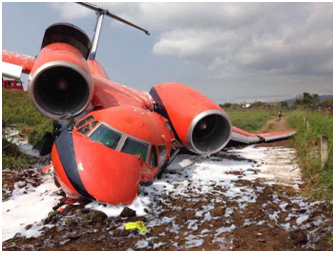
(Photo by Yuri Lavrenyuk taken from Avherald.com)
- 1 August –Springfield (MO)
UPS A300, during the initial climb the left engine ingested birds prompting the crew to land back 15’ later; - 5 August – Ilorin (Nigeria)
Med-View Airlines B767, rejected take-off after multiple impacts with a flock of birds; - 6 August – Indianapolis (IN)
Frontier Airlines A320, during the initial climb the crew reported they had a bird strike and decided to land back; unknow damage; - 6 August – London (Gatwick)
Aer Lingus A320, after departure the aircraft was struck by a bird; the crew decided to continue the flight but subsequently decided to divert to Dublin as a precaution; - 8 August – Columbus (OH)
Republic Airlines ERJ 175, on departure an engine ingested a bird prompting the crew to reject takeoff; substantial damage; - 9 August - Thiruvananthapuram (India)
Air Arabia A320, bird strike during the initial climb; landed back 20’ later; - 13 August – New York JFK (NY)
Jetblue A320, on short final a bird impacted the aircraft; damage to the leading edge of a wing; - 13 August – Montevideo
Avianca A320, during the initial climb flew through a flock of birds receiving several strikes; landed back 50’ later; - 13 August – Saskatoon
Air Canada ERJ 190,rejected take off at 90 kts after the crew observed a flock of birds on the runway; - 13 August – Stuttgart
Eurowings A319, rejected take off at high speed due to a bird strike affecting both engines; during the take-off run the left hand engine ingested a bird causing severe damage to all fanblades; fragments of the fan blades accelerated forward impacting the engine inlet as well as the slats/flaps and forward fuselage; fragments also flew over to the right hand side and were ingested by the right hand engine resulting in fan blade damage of the right hand engine, too; the left engine inlet received several punctures, the fan case, slats/flaps and forward fuselage several dents; the occurrence was not rated accident or serious incident, an investigation has not been opened; local media talk about an impact with a Grey Heron (Ardeacinerea);

(Photo taken from Avherald.com) - 16 August – Gulyali (Turkey)
Pegasus A320, on approach a bird impacted the radome; next flight cancelled;
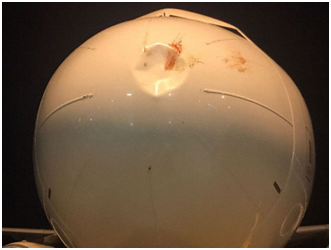
(The damaged radome; photo HavaSosyalMedya taken from Avherald.com) - 17 August – Chicago (IL)
United Airlines B737, during the approach an engine ingested a bird; minor damage; - 17 August – Chicago (IL)
American Airlines B737, on short final a bird impacted the nose gear; minor damage; - 18 August – Grand Forks (ND)
Skywest CRJ200, during rotation an engine ingested a number of birds prompting the crew to land back; the crew advised they had no engine failure or engine fire indication, however, requested the emergency trucks to follow them to the gate; an inspection found about 25 dead seagulls on the runway; - 19 August – Orlando (FL)
Spirit Airlines A320, during the initial climb at about 3500 ft. struck a bird that caused damage to the leading edge of the left wing; immediate return 20’ later; - 23 August – Istanbul (Ataturk)
THY A330, during the initial climb an engine ingested a bird prompting the crew to land back 9’ later; - 27 August – Salt Lake City (UT)
Delta B757, on approach crossing 6000 ft. the crew observed a number of birds but everything looked normal; after the landing an inspection revealed minor damage to the right engine; - 29 August – Trabzon (Turkey)
THY A321, bird strike on final; damage to the radomeand aircraft unable to continue its schedule; - 30 August – Vishakhapatnam (India)
Indigo A320, rejected take off at high speed due to a bird ingestion into the right engine; - 31 August – Boston (MA)
Jetblue A320, bird strike during the approach; minor damage to the right side of the fuselage; - 7 September – Chicago (IL)
Delta B717, after take-off flew through a flock of birds at 1500 ft.; the crew decided to continue to destination where minor damages due to bird impacts were revealed; - 7 September – Portland (OR)
Horizon Dash 8, during the landing roll out a bird impacted the aircraft; the aircraft sustained damage to a windshield as result of the bird strike; - 9 September – Raipur (India)
Indigo A320, an engine ingested a bird just after take-off prompting the crew to land back 20’ later; - 9 September – Newark (NJ)
United B777, an engine ingested a bird on landing receiving damage; - 12 September – Tabriz (Iran)
ATA Airlines MD-83, an engine ingested a bird just after take-off prompting the crew to land back 10’ later; - 12 September – Funchal
TuiFly B737, during the final approach a bird hit the nose cone causing a dent; return flight cancelled;

(Photo taken from Avherald.com) - 18 September – Bentonville (AR)
Envoy ERJ175, during the final approach a bird struck the aircraft radome; return flight cancelled;
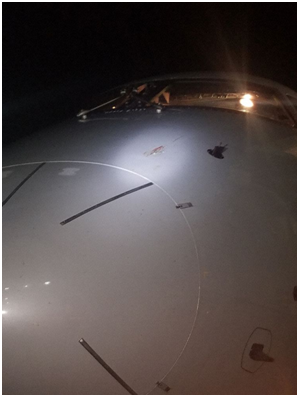
(Photo taken from Avherald.com) - 21 September – Cardiff
Flybe ERJ195, during the initial climb a bird hit the aircraft prompting the crew to land back 25’ later; the aircraft needed to be replaced; - 24 September – Kuwait
Kuwait Airways A320, during the initial climb an engine ingested a bird; in the absence of abnormal parameters, the crew continued the flight to Tehran; a post flight inspection revealed damage to the fan blades that did not allow the next flight;

(The damaged fan blades. Photo taken from Avherald.com) - 24 September – Karthoum
Badr Airlines B737, during the final approach to Khartoum a bird identified as an African Fish Eagle (Haliaeetusvocifer),impacted the aircraft's radome with the remains coming to rest inside the aircraft's nose causing internal structural damage; the eagle can weight up to 3,5 kg;
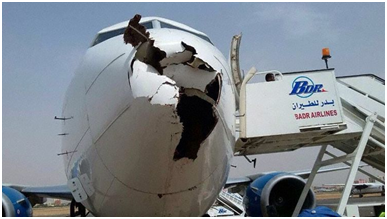
(The damaged radome. Photo taken from Avherald.com) - 26 September – Salt Lake City (UT) or Orlando (FL)
Delta B737, 10 minutes after landing the crew reported a possible bird strike causing damage to the left horizontal stabilizer's leading edge; - 26 September – Enroute between New York and Dallas
American Airlines A321, bird strike probably enroute; minor damage; - 27 September – Raipur (India)
Indigo A320, during the initial climb the aircraft received a bird strike prompting the land back about 40 minutes after departure;flight cancelled; - 27 September – Dallas (TX)
Envoy ERJ145, on landing struck s bird on the runway; minor damage; - 28 September – Newark (NJ)
Delta MD88, during the approach struck a bird; damage to the angle of attack indicator; - 30 September – Portland (OR)
Skywest ERJ175, during the initial climb the left engine ingested birds causing the engine to fail; the crew shut the engine down and landed back about 12 minutes after departure;
Last December (2016, and let us apologize for the delay in reporting), ENAC issued a paper for aircrews on the risk of impact with wildlife. We warmly welcome the long-awaited initiative that fills a gap in the pilot's professional training. Maybe not all the line pilots, but surely all the thousands of general aviation pilots (and not only).
In this regard, we would like to emphasize some of the fundamental recommendations in the document, which we believe are "revolutionary" in a positive way, times being what they are:
- It is recommended to reject take-off in case of impact or, if unable, to make a precautionary landing as soon as possible.
- In case of uncertainty, do not take-off if birds are observed on the runway ... In these circumstances notify the Control Tower or ATS about the presence of wildlife so that they will alert the local BCU that will remove the hazard.
- If high concentrations of birds, or wildlife, are expected near the airport where you intend to land ....a 30% speed reduction will result in a halved impact energy!
- If during the approach there are flocks (of birds) ....it's good practice to make a temporary go-around, alerting the Tower for a BCU action in order to disperse the wildlife.
- There is no scientific evidence in favour of the weather radar as a deterrent system.
Apart from this, the ENAC document represents a major step forward in involving other stakeholders in preventing impacts with wildlife.
The Bird Strike Committee Italy, a branch of ENAC, published the 2016 report (in Italian) on wildlife strikes. Let us suggest to read the whole document while, as usual, we propose our observations and comments that can be downloaded here (a short summary in English).
- 1 April - Boston (MA)
after take-off the crew asked the tower they needed a runway inspection for a possible bird carcass; the flight went on but later was diverted to Orlando (FL) for landing gear problems; the flight continued with a replacement aircraft; - 1 April – Xiamen
China Eastern A320, during the final approach a bird impacted the left engine causing damage to the engine nacelle; return flight cancelled; - 5 April – Pensacola (FL)
Envoy ERJ 170, during the final approach a bird impacted the right engine causing damage to be assessed; - 8 April – Milwaukee (WI)
Federal Express A300, during the initial climb the crew reported a bird strike to the Tower and decided to land back 7’ later; the flight continued with a replacement aircraft; - 8 April – Washington (DC)
American B737, on landing struck a bird; minor damage; - 8 April – Teheran
Lufthansa B747, on final approach the aircraft flew through a flock of birds and received a number of bird strikes suffering damage to the leading edge and landing light of the right hand wing, the fuselage as well as an engine cowl;

(Photo Danial Omidvar taken from Avherald.com) - 9 April – Cape Town
Mango B737, during the initial climb a Pelican (species unknown) impacted the leading edge of the left hand horizontal stabilizer causing a large dent; the crew continued the climb up to FL 330 then decided to land back in Cape Town;

(The dent caused by the impact with a Pelican. Photo taken from Avherald.com) - 9 April – Raipur (India)
Indigo A320, during the initial climb a bird impacted the nose cone causing a dent; immediate return 35’ later and aircraft replacement;
http://www.financialexpress.com/india-news/kolkata-bound-indigo-flight-made-emergency-landing-at-raipur-airport-after-bird-hit/621678
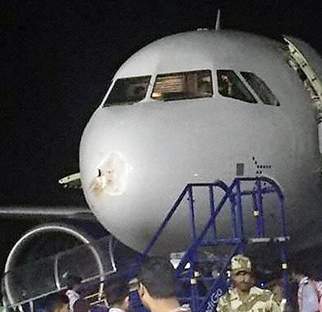
(Photo News World India) - 11 April – Varanasi (India)
Jet Airways B737, during the final approach the right engine ingested a bird causing damage to three fan blades; return flight cancelled;
http://www.hindustantimes.com/india-news/varanasi-bird-hits-jet-airways-flight-passengers-stranded/story-7z8Vrq78ilq7POuYnruZDN.html - 14 April – Newark (NJ)
Elite Airays CRJ 700, during the approach flew through a flock of large birds suffering damage to a wing; - 15 April – Amsterdam
Alitalia A320, rejected take off at high speed (130 kts) due to a bird strike; flight delayed by 2,5 hours; - 21 April – Lagos
Dana MD83, during the initial climb an engine ingested a bird; the crew shut the engine down and landed back; - 24 April – Kolkata (India)
Air India B787, on approach an engine ingested a bird;
http://www.hindustantimes.com/kolkata/delhi-kolkata-air-india-flight-carrying-250-passengers-hit-by-bird-landing-safe/story-jDUeT8ZZTdNJCYOekL4vCI.html - 26 April – Washington (National) (DC)
Republic Airways ERJ175, during the initial climb at about 3000 ft. flew through a flock of birds receiving a strike; the crew decided to divert in emergency to Dulles airport; - 27 April – Sao Paolo (Congonhas)
LATAM Brasil A320, during the take-off struck a bird leaving debris on the runway; the crew decided to divert to Gaurulhos; Congonhas runway remained closed for 150 minutes;
http://g1.globo.com/sao-paulo/noticia/aviao-da-latam-decola-de-congonhas-e-faz-pouso-de-emergencia-em-cumbica.ghtml - 3 May – Moscow (Vnukovo)
Turkish Airlines A330, during the initial climb flew through a flock of birds and suffered several strikes; immediate landing and grounded aircraft; - 3 May – Naples
Aer Lingus A320, during the initial climb flew through a flock of birds and an engine ingested one of them; the aircraft landed back about 40’ later; according to some sources both engines ingested birds;
https://www.thesun.ie/news/947774/dublin-bound-aer-lingus-plane-forced-to-turn-back-after-aircraft-encounters-bird-strike - 4 May – Madrid
TAROM B737, during the final approach an engine ingested a bird; the aircraft could not fly the return leg and had to be replaced; - 4 May – Sao Paulo (Viracopos)
Azul Linhas Aereas ERJ 195, during the initial climb a vulture impacted the aircraft just below the captain's windshield causing damage affecting pressurization; immediate return; a further inspection also revealed the left hand ice detector was fractured;
http://g1.globo.com/sp/campinas-regiao/noticia/colisao-com-urubu-forca-aviao-a-retornar-para-viracopos-logo-apos-decolagem.ghtml - 8 May – Kolkata
Emirates B777, during the final approach the left engine was struck by a bird that caused minor damage; bird remains found on the left wing; the aircraft was unable to depart for its return flight;
http://gulfnews.com/news/uae/society/emirates-in-kolkata-airport-bird-strike-1.2024100 - 9 May – Bucharest
Blue Air B737, suspected bird strike during the initial climb; landed back after 55’; aircraft replaced; - 12 May – Ekaterinenburg
Ural Airlines A321, during the initial climb an engine ingested a bird; immediate return and aircraft grounded; - 12 May – Trondheim
Norwegian Air Shuttle B737, during the final approach an engine infested a bird; the aircraft was unable to continue the schedule;
https://www.thelocal.no/20140102/bird-strike-forces-norwegian-plane-to-turn-back
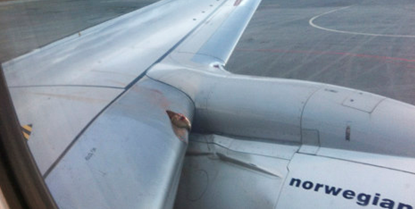
(Bird remains on the left wing - Photo: Kristine Askvik/Scanpix) - 13 May – Brussels
Brussels Airlines A319, during the initial climb the aircraft received a bird strike and the crew decided to land back; after a 80 min. stop on the ground the aircraft departed again; - 14 May - Catumbela (Angola)
TAAG Angola Airlines B737, on approach the aircraft flew through a flock of birds and took a number of bird strikes to an engine that resulted damaged; - 15 May - Karachi
Serene Air B737, during the initial climb the aircraft received an impact with a bird that caused a crack in the windshield; immediate return and flight cancelled;
- 16 May – Bogota
Avianca A320, during the initial climb the crew suspected a bird strike; in the absence of any abnormal indications the crew decided to continue the flight to destination (Mexico City, 4h10’ flight);an inspection revealed damage to one of the engines that forced the airline to cancel the return flight; - 17 May – Washington (Dulles)
Jetblue ERJ190, during the initial climb the crew reported they had hit something during rotation that caused a lot of noise from the nose wheel; ATC reported a bird was found on the runway; the crew then reported the vibrations had increased, declared emergency and requested emergency services on the runway; after landing the emergency staff reported a fuel leak and applied foam;
http://www.dailymail.co.uk/news/article-4518784/JetBlue-flight-makes-emergency-landing-birdstrike.html - 18 May – Columbus (OH)
Mesa Airlines ERJ 175, during the initial climb a bird struck the left engine; the crew decided to land back immediately; minor damage; - 21 May – Hyderabad (India)
Cathay Pacific A330, during the initial climb suffered a bird strike onto the right side of the nose cone; immediate return 20’ later; - 29 May – Moscow (Domodedovo)
Izhavia Yak-42, during the initial climb an engine ingested a bird prompting the crew to land back 15’ later; aircraft replaced; - 29 May – Karachi
Serene Air B737, on approach a bird impacted the leading edge of the left hand wing and punctured the inboard slat;
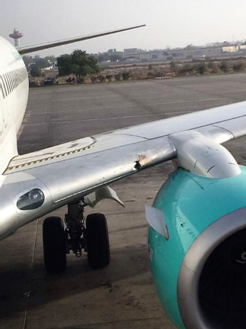

(Photos taken from Avherald.com) - 30 May – Ahmedabad (or Delhi)
Air India A321, after landing in Delhi, the airport of departure reported that a dead bird and metallic parts of a pitot probe were found on the runway; the airline reported the aircraft suffered a bird strike on landing while the crew confirmed they did not observe any abnormal indicationduring the flight; - 31 May – Bucaramanga (Colombia)
Avianca A320, during the initial climb a bird impacted the nose cone causing a dent; immediate return 25’ later;
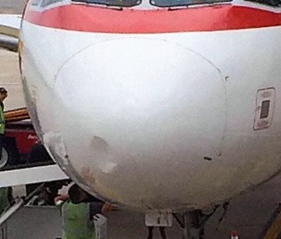
(Photo taken from Avherald.com) - 1 June – Rijeka
Bulgaria Air ERJ190, after take-off the left engineingested a bird and began to severely vibrate prompting the crew to immediately land back about 6 minutes after departure; - 1 June – Chicago
United B737, after take-off the right engine ingested a bird resulting in a number of bangs and streaks of flames from the engine; the crew shut the right engine down and landed back about 25’ later; - 5 June – Merida (Mexico)
Interjet A320, during the initial climb a bird was ingested into an engine; immediate return 25’ later; - 10 June – Leipzig
Volga Dnepr Antonov An 124, when slowing down after landing with reverse thrust engaged, one bird was ingested into the no. 3 engine;
http://www.youtube.com/watch?v=Qa9jC7QbUnw - 12 June – Istanbul
THY B737,in the initial climb the crew reported there was a flock of sea gulls, about 300 birds, on the runway; the crew continued the climb but then decided to return to Istanbul as result of a bird strike; - 16 June – Cuiaba (Brazil)
GOL B737, during the initial climb the right engine ingested a bird prompting the crew to shut it down and to return for landing 25’ later; - 16 June – Dallas (TX)
Southwest B737, in the initial climb one engine ingested birds prompting the crew to return for landing about 10 minutes after departure; flight cancelled;unknown damage to be assessed; - 21 June – Delhi
GoAir A320, during the initial climb a bird struck the aircraft prompting the crew to return for landing about 20’ later; India’s media reported however that the crew shut down the good, unaffected engine after a bird had been ingested by the other engine during take-off; the crew soon recognized their mistake and restarted the shut down engine;
http://timesofindia.indiatimes.com/city/delhi/pilots-switch-off-healthy-engine-after-bird-hit/articleshow/59276868.cms
- 25 June – Santa Cruz de la Palma (Spain)
Iberia Express A320, after take-off the aircraft flew through a flock of birds and the left hand engine ingested a number of them; the crew decided to divert to the airport of Las Palmas 45’ later; - 29 June– Inverness
Easyjet A320, during the initial climb an engine ingested a bird; immediate return 30’ later; - 30 June – Bourgas
Condor A321, during the initial climb the left engine ingested a bird; the crew declared emergency and landed back immediately; the aircraft was unable to depart for the return flight; - 30 June – Cairo
Saudi Arabian Airlines A330, during the final approach a bird struck the nose cone causing a dent;
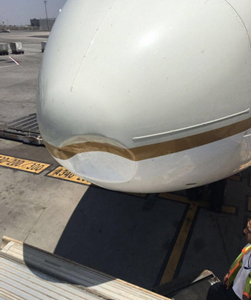
(Photo taken from Avherald.com)
The Italian Agency for Flight Safety (ANSV) recently published its 2016 report on the civil aviation safety. In contrast to the past years, when at least few lines were dedicated to the issue, this year the matter completely disappeared from the report, with the exception of a short note regarding the number of bird strike reports to be taken into consideration: “ANSV decided to consider only reports that regard actual damage to aircraft”.
In a recent trial, the European Court declared that "a collision between an aircraft and a bird is an extraordinary circumstance". Therefore, airlines can reject claims for compensation from passengers, as stated in the Reg. EC 261, in case of delay or flight cancellation. The verdict obviously was welcome by European airlines that have seen recognized their right not to be responsible for events that occur beyond their control; it left instead disappointed many Consumers’ Associations that are managing pending compensation requests for millions of Euros. If it is true that in so many cases a bird strike cannot be avoided by an aircraft (therefore without fault or responsibility), it is true as well that many bird strikes can be prevented by the adoption of proper measures by other subjects (i.e. airport operators and others). In conclusion, we think that a new damage compensation system is needed, fast and certain like that provided by the EC261, also at the expense of other entities.
On May 2017 ENAC released its 2016 Corporate Annual Report:
http://www.enac.gov.it/repository/ContentManagement/Information/P1535127749/ENAC 2016 ita low.pdf
Inside the report, a page (pag. 109) has been dedicated to the Wildlife Strikes. It does not contain novelties, apart from a preview of the 2016 strike data, not definitive yet. The text recalls more or left the same concepts and the same information of the past years, but at least it shows the ENAC will to consider the problem of wildlife strike as important and still existing, differently from other important entities that completely omitted even to mention it (see below the controversial choice of ANSV).
From 2012 to 2016 EASA received from the 27 joint countries 13.003 reports of bird/wildlife strikes, with 2 events of serious incidents, with regard to commercial air transport aeroplanes. For further details, please download the report at the link below:
Kenya's AAID (Aircraft Accident and Incident Investigation) released their final report on the accident occurred to the aircraft Fokker 50 5Y-SIB on 4 January 2015. The left hand main gear did not extend and lock in the down position due to the impact with two birds that disabled proper functioning of the mechanical system that controls the opening and closing the door to the left main landing gear (MLG). The crew then decided to perform a belly landing (with all gear up) and landed the aircraft. No injuries occurred but the aircraft suffered substantial damage.
The AAID also released several interesting recommendations we may agree with, but did not mention the crucial point, in our opinion, regarding the need of a better shielding of the landing gear apparatus in case of bird strikes. The topic has been recently discussed during the WBA meeting in Amsterdam on December 2016.
The meeting took place in Montreal from 15 to 18 May 2017 and was organized by ICAO and ACI (Airports Council International). The following is the link to download the several presentations:
Our comments on this important conference can be released in the near future.
- 8 January – Los Angeles (CA)
Southwest B737, bird strike during the initial climb; immediate return 35’ later; the impact caused minor damage to a passenger window;
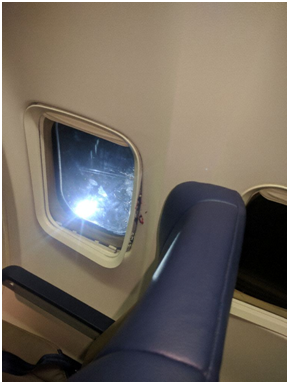
(Photo taken from Avherald.com) - 10 January – Bournemouth
Thompson Airways B737, during the initial climb the left engine ingested a gull and emitted a loud bang followed by vibrations; the crew decided to return diverting to Gatwick;
https://assets.publishing.service.gov.uk/media/58a2e47f40f0b6070b000038/Boeing_737-8K5_G-FDZY_03-17.pdf - 17 January – Phoenix (AZ)
American Airlines A319, during the approach about one mile before touchdown a large bird impacted the aircraft and was ingested into the right engine; damage to be assessed; - 20 January – Curacao
KLM B747, during the initial climb an engine ingested a bird; the crew decided to return after having dumped fuel; - 20 January – Lincoln (NE)
Skywest CRJ200, after take-off crossing 1500 ft. suffered a bird strike; in the absence of abnormal indications the crew continued to destination (1 hour flight); after landing an inspection revealed damage to the aircraft; - 21 January - Charlotte (NC)
PSA Airlines CRJ 900, during the initial climb at about 500 ft. impacted with some birds; in the absence of abnormal indications the crew decided to continue to destination (Richmond VA) where the radome was found damaged; - 21 January – Chicago (IL)
Nippon Cargo B747, during the initial climb at 1500 ft. flew through a flock of about 20/25 large birds that hit the windscreen and surrounding areas; in the absence of abnormal indications the crew firstly decided to continue the flight to destination (Frankfurt), but later decided to return in order to have the aircraft controlled;
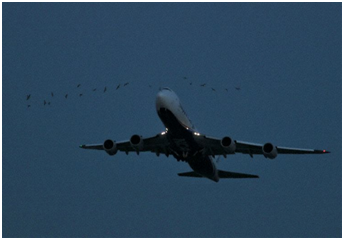
(The aircraft and the birds right before the impact; photo taken from Avherald.com) - 24 January – St. Louis (MO)
Gojet CRJ 700, during the initial climb at 4500 ft. a bird hit the windshield causing it to crack; immediate return 10’ later; - 24 January – Amsterdam
Austrian Airlines A319, during the approach at about 2000 ft. flew through a flock of birds, a number of which hit the aircraft; the return flight had to be cancelled due to the damage;
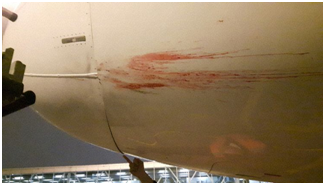
(Signs of the impacts on the radome; photo taken from Avherald.com) - 26 January – Jackson (MS)
Delta MD88, during the approach at about 2500 ft. struck a large bird that caused a dent in the nose and damage to the angle of attack sensor; - 28 January – Milan (Malpensa)
PIA B777, during the approach a bird or other unidentified object impacted the aircraft and caused minor damage to the tail; next two flights postponed to the next day; - 28 January – Goiania (Brazil)
Gol B737, during the initial climb at 2350 ft. and at 220 kts. the crew observed a small flock of birds on the left; moments later the left engine begun to vibrate due to bird ingestion prompting the crew to shut it down and return for landing; damage to the inlet and the engine; - 2 February – Trieste (Ronchi dei Legionari)
Lufthansa CRJ900, rejected take off and returned to the parking area due to a suspected bird strike; - 2 February – Manchester
Easyjet A319, during the initial climb an engine ingested a bird; immediate return; - 6 February – Bhopal (India)
Air India A319, during the initial climb a bird impacted the aircraft; in the absence of abnormal indications, probably remaining unaware of the bird strike, the crew continued the flight, climbed the aircraft to FL320, but about 5 minutes after levelling off at FL320 descended the aircraft to FL270; the crew then decided to divert to Jaipur indicating they were diverting due to the adverse weather conditions at destination (Delhi); while on approach the crew reported being low on fuel and requested priority, immediately provided; after landing a fuel leak from one of the engines and the signs of a bird strike weredetected; the airline investigates why the crew remained unaware of the bird strike in flight; - 7 February – Fort Lauderdale (FL)
Southwest B737, bird ingestion into the left engine during the final approach; - 9 February – Lagos
Qatar Airways A330, after take-off a bird hit the left engine; precautionary landing back;
https://www.bellanaija.com/2017/02/qatar-airways-aircraft-incident-was-a-bird-strike-ncaa - 10 February – Amsterdam
KLM B787, a suspected bird strike at departure prompted the crew to land back; the aircraft remained on the ground more than two days after landing back; - 13 February – Fort Lauderdale (FL)
Spirit Airlines A319, multiple impact with birds at departure; returned 50’ later; - 13 February – Tucuman
Aerolineas Argentinas B737, during the approach the right engine ingested a bird; return flight cancelled due to the damage to some fan blades;
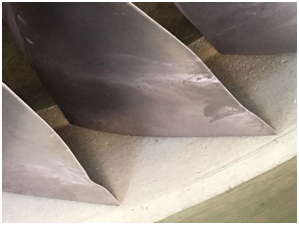
(The damaged fan blades – Photo taken from Avherald.com) - 14 February – Brasilia
LATAM A320, struck a bird at the rotation; returned 18’ later due to the high vibrations caused by the ingestion;
http://g1.globo.com/distrito-federal/noticia/com-destino-a-sp-aviao-da-latam-deve-voltar-ao-df-apos-bater-em-passaro.ghtml - 15 February – Charlotte (NC)
PSA Airlines CRJ700, in the initial climb the crew reported a loud bang; a runway inspection found a dead deer on the runway; then the crew positioned for a low approach to have the gear inspected from the ground receiving the information that all three gear were in position; in the meanwhile either from the tower and from another pilot it appeared there was vapour coming off the right side and the right engine appeared to be leaking; after landing the fire crew confirmed the fuel leak from the right engine, reported a lot of fuel on the runway and foamed the aircraft; the occupants exited the aircraft rapidly; damage to the leading edge of the right wing due to the impact with a deer;
Five previous incidents are known to have happened at Charlotte-Douglas International Airport involving deer:
In 1994 a USAir DC-9 returned after hitting a deer on takeoff; no damage.
In 1996 a USAir Boeing 737-300 hit several deer after landing; minor damage.
In 2002 a Piedmont Airlines DHC-8 hit a deer after landing, causing the nose landing gear to collapse
In 2009 a Repubic Airlines ERJ-170 hit a deer after landing on runway 36C; no damage.
In 2010 a US Airways Boeing 737-400 hit a deer after landing; no damage;
(source: Aviation Safety Network)
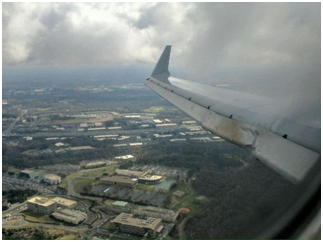
(Photo by Shelby Myers taken from Avherald.com) - 15 February – Buenos Aires (Ezeiza)
Aerolineas Argentinas A340, rejected take off at high speed (110 kts) following a bird ingestion into an engine on the right wing; - 20 February – Chiclayo (Peru)
LCPeru B737, bird ingestion into an engine with presence of smoke and smell in cabin; in the absence of abnormal parameters the flight continued to destination (Lima); - 24 February – Charlotte (NC)
Delta MD88, during the initial climb flew through a flock of small birds; after few minutes the crew decided to land back; - 27 February – Omaha (NE)
Southwest B737, multiple bird strike on short final; damage to wings and landing gear; - 1 March – Fort Lauderdale (FL)
Jetblue ERJ190, on final approach a bird impacted the aircraft nose; damage to the nose gear lights; - 5 March – Dallas (TX)
American Airlines A321, on final approach the left hand engine ingested a number of birds receiving damage; - 8 March – Tampa (FL)
United B737, at take-off struck some ducks and made a precautionary landing back; - 12 March – Stockholm (or Belgrade)
Wizzair A320, after landing in Stockholm found signs of a bird strike: feathers and a dent on the nose cone; - 15 March – Berlin (Schoenefeld)
during the approach at about 3000 ft. struck a bird that caused a large dent in the nose cone; the aircraft could not operate the next leg; - 19 March – Minsk (Belarus)
Belavia B737, during the initial climb at about 500 ft. flew through a flock of birds one of which was ingested into one engine prompting the crew to return immediately 20’ later; - 19 March – Christchurch
Virgin Australia B737, during the initial climb a bird was ingested into an engine causing vibrations due to a fan blade damaged; immediate landing 30’ later; - 21 March – Multan (Pakistan)
Airblue A320, rejected take off at high speed (110 kts.) due to a bird ingestion into the left engine; - 22 March – London (Heathrow)
Air India B787, during the approach a bird impacted the radome causing a large dent and damaging the weather radar system; next leg cancelled;
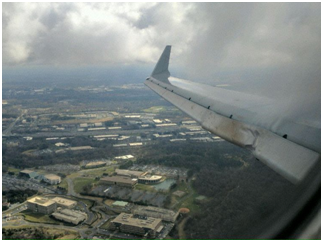
Photo Mayur Parikhþ taken from Avherald.com) - 24 March – Kathmandu
Air Arabia A320, during the initial climb suffered a bird strike that forced the crew to divert to another airport for landing; - 25 March – Muscat (Oman)
Qantas A380, forced to divert to Muscat for weather reasons, on approach impacted with a bird; after landing the aircraft could not continue the flight to the initial destination; - 26 Marzo – San Jose (CA)
All Nippon Airways B787, on final approach flew through a flock of birds receiving several strikes; return flight cancelled; - 27 March – Cordoba (Argentina)
LATAM Chile A321, during the initial climb flew through a flock of birds some of which were ingested into the left engine; immediate return 25’ later;
The European Union is funding a project (LIFE14 NAT / IT / 000484) which has as main objective the improvement of the state of conservation of the Griffon vulture in Sardinia. The project includes, among other issues, the creation of a network of so-called "farmers carnia" to mitigate the food shortage and the release of 60 Griffons from Spain to resolve the critical demographic situation of the existing population.
“Farmers carnia" (i.e. charnel-houses) are equipped sites where the farmers are allowed and encouraged to leave livestock carcasses in selected areas where Griffons live. The carcasses will provide food for the Griffons that therefore can feed themselves, as once happened in nature. Furthermore, there will be two additional and similar “feeding stations” to integrate the network of the “farmers carnia”.
The project includes the following Special Protection Areas (SPA) and Sites of Community Importance (SIC): ZONES SPA: ITB013044 - Capo Caccia: its inner area, known as the "Arca (Ark)", is a permanent wildlife protection oasis (L.R. 23/98), while the coastline is part of the Marine Protected Area (MPA) of Capo Caccia and Punta Giglio (L. 979/82). That is a permanent oasis of wildlife protection and capture. The area falls within the Porto Conte Regional Park (L.R. 31/89) and it is considered one of the most important breeding sites for the Gyps fulvus and the Hydrobates pelagicus.
ZONES SIC: ITB010042 - Capo Caccia (with the islands Foradada and Piana) and Punta del Giglio - ITB011155 - Lake Baratz, Porto Ferro: the only natural lake in Sardinia, fed only by the catch basin that surrounds it. Geologically the area consists of formations of sedimentary rocks, mainly sandstones and sands, and metamorphic rocks of schist type.
Pending the entry into operation of the “farmers carnia”, one of the feeding stations has been located in Marina di Lioneddu (Porto Conte).
So far, that is what we can read in the project website called "Life Under Griffon Wings"
Due to some unfortunate circumstances, the project designers, and many of the entities in charge of controlling and authorizing it, must have neglected the fact that all the areas described above are located within a 13 km. radius from the civil airport of Alghero.
The distance of 13 km. has been set as a limit, under the national (Civil Aviation Authority) and international (ICAO) regulation, in order to avoid the settlement of attractive sources for wildlife, considered as potential hazards to air navigation (Cod.Nav. art. 711). In fact, the local airport Authority years ago delivered to the Municipality of Alghero, within whose boundaries both the airport and the project areas fall, the so-called constraint maps (Art. 707 C.N.), i.e. the territorial boundaries within which wildlife potential attractive sources are in general not allowed.
At least one of the feeding stations is therefore already existing and active within a radius of 13 km. from the airport, while the others (“farmers carnia”) will be completed as soon as the authorization process will end.
What could be the impact on air navigation safety resulting from a population of more than 60 Griffons hovering above two feeding stations within a zone which should be immune from attractions sources?
The Griffon vulture (Gyps fulvus) has a wingspan of 2.5 m. and can weigh up to 12 kilos. It can fly up to 6,000 m. (about 20,000 ft.). Griffons can form separate colonies and are quite loyal to their permanent locations. Usually they move in flocks of several individuals. With a network of feeding stations and “farmers carnia”, it is very likely that the flocks will move from one to another inevitably crossing the take-off and landing paths of Alghero airport.
In Spain, where about 8,000 pairs of Griffons live, statistics show many collisions with military aircraft that often carry out missions at low altitude (certainly more than 14 events from 1987 to 1991- Kitowsky 2011), but also with civil aircraft, causing several casualties among pilots and passengers of small general aviation airplanes.
The following are the updated data of the latest impacts, as reported by the media:
-
18.07.1996, Pamplona, Robin DR380, crashed after colliding with a Griffon vulture, 3 dead;
-
13.05.2012, Madrid, Iberia A340, struck a vulture that remained embedded in the nose cone;
-
16.01.2016, Cerro de las Rabadanes, TB20, struck a vulture, 4 dead;
-
30.03.2016, Perales, Cessna 172, collided with a vulture, 3 dead;
-
19.05.2016, Arbizu, Robin DR400, collided with a vulture, 3 dead;
-
16.09.2016, Palma de Mallorca, Lufthansa A320, struck a vulture that remained embedded in the nose cone;
We think no additional comment is needed.
If no expert will ever support the feasibility of a “zero hazard” with regard to the impacts of aircraft with birds, we really do not feel any need to increase the hazard level if we can easily do without. We hope, therefore, that the project managers would reconsider the location of such attractions sources and restocking, maybe moving them to areas less critical for air navigation.
Finally, we would like to mention a similar experiment underway in India (although for different needs and in a different context) in which however the feeding stations have been located at 100 km. from the nearest airport: